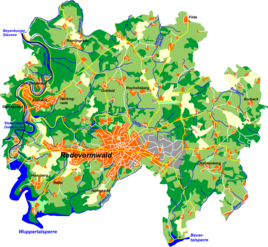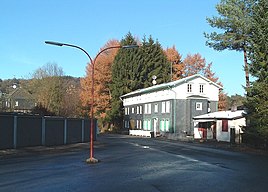Wilhelmstal (Radevormwald)
|
Wilhelmstal
City of Radevormwald
Coordinates: 51 ° 12 ′ 20 ″ N , 7 ° 18 ′ 9 ″ E
|
||
|---|---|---|
| Height : | 230 m above sea level NHN | |
| Residents : | 156 (December 1, 2004) | |
| Postal code : | 42477 | |
| Area code : | 02191 | |
|
Location of Wilhelmstal in Radevormwald |
||
|
A residential building in Wilhelmstal
|
||
Wilhelmstal (in earlier spelling Wilhelmsthal , until the 19th century Krebsholl ) is a place in Radevormwald in the Oberbergischer Kreis in the North Rhine-Westphalian administrative district of Cologne in Germany .
location
The place is in the far west of the city on Haller Bach on the border with Remscheid directly on the Wupper . The neighboring towns are Krebsöge , Rechelsiepen , Oberdahlhausen and Sieperhof (Wuppertal). Wilhelmstal can be reached via the federal road 229 , which leads from Remscheid- Lennep to Lüdenscheid . The Wupperlauf is still influenced in Wilhelmstal by the dam in Dahlhausen .
In addition to the housing developments that have arisen from the workers' quarters of a former cloth factory, various business settlements dominate the area.
history
The place was called Krebsholl until the 19th century and was first mentioned in 1493 as Krefftzholl , the map Topographia Ducatus Montani from 1715 shows the farm as Griftsholl . The topographical survey of the Rhineland names the place in 1824 as Krebsholl and the Prussian first survey of 1840/44 as Cristhohl . Finally, the name Wilhelmsthal appears on the measuring table pages of the topographic map 1: 25,000, edition 1892/94 .
Eight residents lived in the village in 1815/16. In 1832 Krebsholl was part of the Altbergian rural community of Fünfzehnhöfe , which belonged to the mayor's office of Wermelskirchen . Which according to the statistics and topography of the district of Dusseldorf as Ackergut designated place was located on the border with the mayor Luettringhausen and had at this time two houses and two farm buildings. At that time ten residents lived in the place, all of them Protestant faith.
On June 1, 1833, a Georg Heinrich Stuhlmann received permission to build a small cloth factory on the Haller Bach. Cloth was processed on a hoisting machine and two cylinder cutting machines. In 1845 the installation of a water turbine was approved, which should have been one of the first in Germany.
The place was shaped from 1856 by the large weaving and cloth factory of the Hilger brothers, who also had the three large workers' houses built in 1870/1872/1874 by master builder Christian Schmidt and the architect Julius Thomas, a cousin of the Hilger brothers. With the transformation of the Krebsholl court into an industrial town, the name of the town changed to Wilhelmstal. Although the Hilger brothers, like Adolph Bauendahl a few years earlier, tried to obtain the right to use the water power of the Wupper, a permit was refused. Nevertheless, the construction of ultimately unused moats and a mill battle began.
In 1866 five steam boilers and two steam engines are in operation in the cloth factory. As the manufacturing plant was partly located on the Fifteenhöfer and partly on the Lüttringhauser area, in 1868 a violent legal dispute arose between the two communities over tax revenues. Almost 600 people work in the plant at the time.
The first section of the Wuppertal Railway was built in 1886 to connect the factories in the Wupper villages . Wilhelmstal also got its own stop on the railway line. The section between Beyenburg and Wilhelmstal belongs to the Wupperschiene Friends' Association and is to be restored as a museum railway.
In the municipality lexicon for the Rhineland province , six houses with 380 inhabitants are given for the year 1885. At that time the place belonged to the mayor's office of Fünfzehnhöfe within the Lennep district . In 1895 the place had seven houses under the name Wilhelmstal with 312 inhabitants, in 1905 17 houses and 299 inhabitants.
A fire destroyed parts of the Hilger brothers' cloth factory before 1890, but the main building was spared. Nevertheless, around 1890 bankruptcy had to be filed and 325 employees became unemployed. The Lennep builder Albert Schmidt was one of the creditors. From 1892 an August Bünger produced corset rods , waist bands and other clothing accessories in the rooms .
In 1898 the industrial building was converted by Carl Cäsar into a paper factory for ticket cardboard and wallpaper paper ; Albert Schmidt carried out the conversion. The operating equipment included two cylinder mold machines , a longitudinal machine and a 650 hp tandem steam machine from MAN to drive the paper machines. The factory was electrified in 1912. Its own electricity was generated by a steam turbine unit, which should also be one of the first in Germany.
In 1906 the mayor's office was incorporated into the town of Lennep . Lennep was again incorporated into Remscheid in 1929 , the eastern outskirts such as Wilhelmstal came to Radevormwald.
In 1927 the factory ran into economic difficulties and was taken over by the Ernst & Luh company from Achern , whose partner Wilhelm Ernst had founded the Mittelbadische Papiermanufaktur a few years earlier . His innovation was the production of paper bags for cement , which was previously usually transported in 100 kg drums. In cooperation with mechanical engineers, testing and manufacturing machines were developed for the sacks that were needed in large numbers for the armaments construction work during World War II . The need for cement sacks was also enormous in the post-war period, so that in 1948 the British occupiers granted permission to restart production.
In 1952 the steam turbine was replaced by a new one from AEG . In the 1959s 150 to 200 people worked in the factory, which was one of five factories owned by Ernst & Sohn . Paraffin crepe , the paper brands Silco-Phan , Ito-Phan and others were produced in Wilhelmstal . The Swedish company Korsnäs took over the factory in the 1960s .
Production was stopped on November 30, 1970 because the production capacity at the site was too small. 135 employees were laid off. The company Körsnäs Wilhelmstal GmbH paper sack factories continued to produce with factories in Achern and Langenfeld (Rhineland) . In 1997, smaller companies settled in the facility, but the main factory is empty and decaying.
Film set
The following films were (partially) shot in Wilhelmstal:
- 2005 For the unknown dog (directors: Dominik and Benjamin Reding, actors: Sascha Reimann , Lukas Steltner , Katharina Lorenz , Peter Rühring )
- 2006 Freischwimmer (director: Andreas Kleinert , actors: Frederick Lau , August Diehl , Fritzi Haberlandt )
Hiking and biking trails
The following hiking trails lead through the village:
- The SGV main hiking route X7 ( Residenzenweg ) from Arnsberg to Düsseldorf-Gerresheim
- The district hiking trail ◇ 6 ( Wupperweg ) of the SGV district of Bergisches Land
- The forest-water-wool-hiking trail
Individual evidence
- ↑ a b Wilhelm R. Schmidt (ed.): Albert Schmidt. A builder from Bergisch. Sutton, Erfurt 2008, ISBN 978-3-86680-400-5 , p. 121 ff.
- ^ Johann Georg von Viebahn : Statistics and topography of the administrative district of Düsseldorf. Part 2: Containing the statistical table of places and distances and the alphabetical index of place names. Schreiner, Düsseldorf 1836, p. 19 .
- ↑ a b c d e f g h Wilhelmsthal on wupperindustrie.de (accessed: January 18, 2015)
- ↑ Rudolf Inkeller: The Wuppertal track. The railway connection Wuppertal - Radevormwald - Bruges (Westf.) (= Rheinisch-Bergische Eisenbahngeschichte. Issue 5). 3rd, revised and updated edition. Kaiß, Leichlingen 2004, ISBN 3-9806103-7-3 , p. 38 f.
- ^ Royal Statistical Bureau (Prussia) (Ed.): Community encyclopedia for the Rhineland province. Based on the materials from the census of December 1, 1885 and other official sources (= community encyclopedia for the Kingdom of Prussia. Vol. 12, ZDB -ID 1046036-6 ). Publishing house of the Royal Statistical Bureau, Berlin 1888.
- ^ Royal Statistical Bureau (Prussia) (Ed.): Community encyclopedia for the Rhineland province. Based on the materials from the census of December 1, 1895 and other official sources (= community encyclopedia for the Kingdom of Prussia. Vol. 12). Publishing house of the Royal Statistical Bureau, Berlin 1897.
- ^ Royal Statistical Bureau (Prussia) (Ed.): Community encyclopedia for the Rhineland province. Based on the materials from the census of December 1, 1905 and other official sources (= community encyclopedia for the Kingdom of Prussia. Vol. 12). Publishing house of the Royal Statistical Bureau, Berlin 1909.
- ↑ Manfred Heymann u. a .: Crab roe "original". The small town before the Wupper Dam was built. A nostalgia. Jungdruck, Radevormwald 2007, p. 56ff.
- ↑ Villa Waldfrieden plays the setting for a tragicomic movie , In: Remscheider General-Anzeiger , October 26, 2005, online version (fee required)
- ↑ The film is being shot in Wilhelmstal , In: Remscheider General-Anzeiger , August 18, 2006, online version (fee required)
- ↑ Film with Rader locations starts , In: Remscheider General-Anzeiger , May 9, 2008, online version (subject to a charge)



